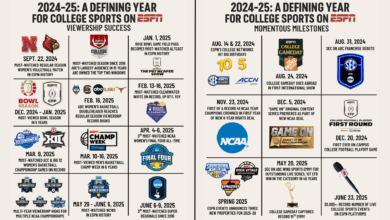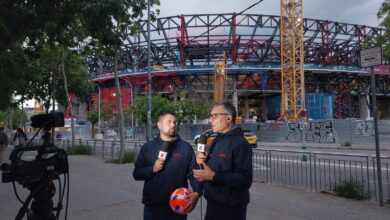ESPN’s “wedding planners” have “Megacast” in mind for BCS finale
PASADENA, Calif. — Technology has advanced and sports-event production has evolved tremendously since ABC and ESPN televised the first of their 52 Bowl Championship Series games on Jan. 1, 1999 (Wisconsin defeated UCLA 38-31 in the Rose Bowl). Amidst all the changes, however, two constants have remained through the years: ESPN Vice President, Remote Production Operations Bob Braunlich and ESPN operations manager Jay Gleeson. As part of the production operations team, first with ABC and then ESPN, they have been responsible for ensuring every BCS game has all the resources necessary for a successful production.
“The telecast is when the bride and groom say their ‘I dos’ and then have the party,” said Braunlich. “Our group is responsible for helping them pick out the rings, set the date, book the venues and vendors, arrange for the food and drink, and then tear it all down and get everyone back to their hotels.”
Needless to say, throwing a wedding, or game telecast in this case, has changed a lot since 1999.
“Technology has advanced tremendously,” said Gleeson. “Many fans have a hard time watching an event that is not in high definition nowadays. In 1999, everything was analog and a wide-screen plasma or LCD TV didn’t exist.”
Other modern day elements that have become expected for a quality viewing experience: the 1st-and-10 yellow line, a constant scoreboard bug, an on-screen digital play clock, scores on a constant bottomline, the Spidercam positioned at the top of the stadium on wires, advanced microphones and a camera to capture every possible angle of a controversial play.
The final championship of the BCS era, Monday night’s VIZIO BCS National Championship Game between No. 1 Florida State and No. 2 Auburn (8:30 p.m. ET, ESPN, WatchESPN), will be the biggest production to date. It will provide a different viewing option of the game across six ESPN television platforms as well as audio and digital outlets. ESPN will use 63 cameras and 72 microphones for the “Megacast” presentation to capture the on-site studio and game coverage. Braunlich and Gleeson remember fielding 22 total cameras for the first BCS title game (Jan. 4, 1999, Tennessee defeated Florida State 23-16 at the Fiesta Bowl).
“Technology has become the best friend of a sports fan and an even better friend for us,” said Braunlich. “In that first game, we used a camera attached to a tethered balloon 500 feet above the parking lot instead of a blimp to give us the aerial shot. It provided us some great scenic views of the city and stadium – until a few hours before the game when it (was punctured). We also didn’t have a major internet service or cell phones so the only form of ‘immediate’ communication was a pager or actually running around to find the person. Having computers and being able to communicate by PDAs has made everything more efficient.”
With technology advances, more equipment becomes necessary which takes more space. The compound area for Monday night’s championship game will be ESPN’s largest ever for a college football game, expanding to the golf course near the Rose Bowl. The compound has grown from a production truck and small support vehicle in 1999 to a minimum of eight production trucks and six production trailers for the BCS Megacast coverage this year.
“We are going to have about 200 people working on-site at the game, that’s double from the first title game,” said Gleeson. “Those 200 people will put in more than 19,000 collective hours in little more than a week working on everything involved in the Rose Bowl and Championship game telecasts, from driving the trucks, to laying cable, to placing microphones, to operating cameras, to breaking it down and packing back up.”








